Entries tagged as asia2013
Related tags
almaty alps asia berlin border bus china coach erlian kazakhstan khorgas koktobe moscow mountains petropavl shymbulak snow train transsiberian travel warsaw yining arcade computerhistory donkeykong gameboy games magistral mario museum nes nintendo retro retrogames retrogaming russia tankodrom videogames wii architecture astana baiterek khanshatyry amusementpark aviation azerbaijan baikal beijing belarus capsulehotel caspian ccp censorship childrensday chinghai cinderella climatechange copyright dam disney disneyland dunhuang ecology erenhot fake ferry flying freesoftware greatfirewall guangzhou haikou hainan hohhot hongkong hostel hotel irkutsk journey kualalumpur language laos lenin listwjanka malaysia metro miradormansion mongolia poland portbaikal publictransport pyramid qwerty rain rainforest sanya seat61 shijingshan stepmania suprememaster terracottawarriors thailand tiananmen ticket tram transport transsib travelling trip2011 typhoon ulaanbaatar ulan-ude ulanude urumqi vegan vegetarian visa waterpower weather windenergy xian xinjiang yanoda yekaterinburg zamyn-uud zensur migrationpolice migrationcard 129a 1mai 23c3 24c3 27c3 a100 abgeordnetenhaus akongress akw allianz anarchiekongress antiatom atheismus atomkraft autobahn bahnhof belene bild brandenburg bundestagunited buskampagne bz ccc cellular compiz creativecommons dataretention datenschutz demonstration dose elephantsdream energie energietisch energiewende freeculture freedomnotfear freifunk freiheitstattangst frequencies frequency fsfe gott gsm informationsfreiheit itu jugendumweltbewegung jukss kamera kameraüberwachung kernkraft klima klimaschutz klimawandel kohle kohlekraft kongress königswusterhausen kyoto lessig linux mcplanet mobilephones moleculeman musik ökologie ökostrom openbsc openbts openstreetmap osm osmocombb papst peterschaar piratenpartei polizeigewalt preise privacy privatsphäre ratzinger re-publica re-publica09 religion rp09 rwe science security sony springer strom stromnetz tagebaue taz theory thermen topberlin treptow tuberlin überwachung ubuntu umwelt umweltschutz unserwasser urgewald verkehr videoüberwachung volksbegehren vorratsdatenspeicherung wahl wasser wg wiki windowsxp wiretapping wirklimaretter wos wos4 youtube zimmer boluo copycat hallstatt huizhou luoyang boten casino ghosttown babelfish chinese coffee english freizeitpark googletranslate journalismus mandarin northwestchina presse pressefreiheit russian tagesschau translation universaltranslator 68 aacs abmahnung alecempire aliens art banksy barrierefrei berneconvention bittorrent bitv blueray brigittezypries buch bücher bundestag cedric chaosradio corruptibles cpdl culturalflatrate culture di drm easterhegg ebook epetition eu eucopyrightdirective evrimsen fanart fanfiction filesharing film funkerspuk gema gemavermutung geodaten graffiti gutenberg gvl hacker hddvd hiddenfrontier html ifpi illegalart iromance jankroemer justizministerium kinderlieder kopierschutz kriegderwelten kts kultur laterne laternenumzug licenses lug markenrecht metis movies mpaa musikindustrie musikpiraten mysmartgrid negativland netradio nocopy patent patente penguinbooks petition piratbyrån piratebay politik publicdomain radio radiopolitik raubdruck raubkopie remix rsa rsaoaep rsapss sanktmartin savenetradio sciencefiction spiritlevel startrek thepiratebay tomcruise trips tuxmas tuxmas07 usa usbstick verwertungsgesellschaft vgmusikeditionen vgwort vlc w3c warez webradio wipo wizo crookedforest forest gryfino nature places adplug ape atari audacious audio c64 chiptune dosbox ffmpeg fileformats game-music-emu gbs gstreamer hvsc imagemagick legacy libav mikmod modplug monkeysaudio mplayer nsf realaudio retrocomputing shn shorten sid sidplay sound totem voc vqf xine blinkenlights brownbox lucasarts monkeyisland olpc painstation pong pongmechanik pongmythos scumm simcity stuttgart wkv blackhat defcon lasvegasSaturday, January 18. 2014
Laos, Thailand, Malaysia and back home
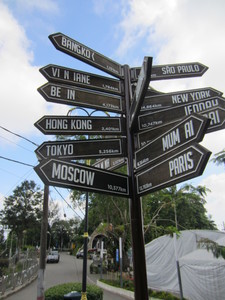
These signs in Penang/Malaysia were quite a good symbol for my trip.
I entered Laos from China, but I didn't spend a lot of time in Laos. The main reason was that I was quite frustrated with the weather. It was a comparatively cold winter in southern China and Laos and the buildings there are not really isolated at all and heating usually doesn't exist. While the days were all sunny and nice, the nights were sometimes quite tough. In Laos, usually the only mode of transport are buses and minibuses. I crossed the border at Houay Xai and quickly moved on to Bangkok by bus and train.
Travelling in Laos and Thailand was quite a different experience when compared to Kazakhstan and China. For the first half of my trip, I mostly felt like "the stranger going to places rarely visited by strangers". In China, even at touristy places there were mostly domestic tourists. Laos and Thailand are flooded with western tourists, so I was more like "the western guy going to places everyone else is going". Honestly, I felt much more comfortable with the first role. Malaysia was somewhat in-between. The most important thing I was looking for in this part of Asia was mostly nature and rainforests.
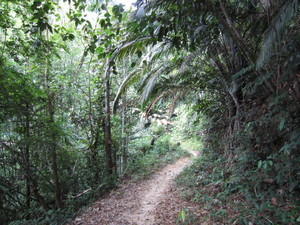
Rainforest in Malaysia.
If you know me, you know that I try to avoid flying. But it was clear that doing this trip without would be close to impossible. So I flew back from Kuala Lumpur in Malaysia earlier this week.
While I've seen a lot and experienced a lot, at the end I was at a point where I really didn't want to continue any more. I have a lot of respect and get inspiration from people people who consider themselves digital nomads, permanent travelers or something alike and I though a lot about that during travelling and in the months before. I'll probably write some more about that at a later point, as I find it quite desirable to organize life in a way to be less dependent on a fixed living spot. But for me, this has limits and I know where they are.
Posted by Hanno Böck
in English, Life
at
13:02
| Comment (1)
| Trackbacks (0)
Defined tags for this entry: asia, asia2013, kualalumpur, laos, malaysia, rainforest, thailand, travel
Tuesday, January 7. 2014
Boten - a chinese casino ghost town in Laos
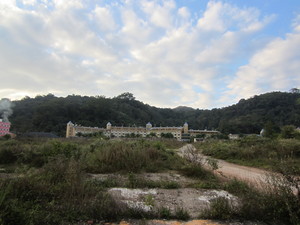
This hotel still takes customers, although there probably aren't many
Right behind the border in Laos is the small town Boten. There's a quite interesting story behind this place. A couple of years ago, this was a place of casinos for chinese gamblers. In China itself casinos are forbidden, so this gained quite some popularity. A couple of luxury Hotels and other facilities for the chinese gamblers emerged. However, some conflicts were arising. The casinos sometimes held chinese gamblers unable to pay their gambling debt as hostages. Chinese authorities were unhappy with this and pressured the laotian authorities to shut the place down, which finally happened in 2011.
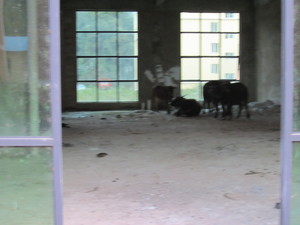
In this former hotel only cows sleep these days
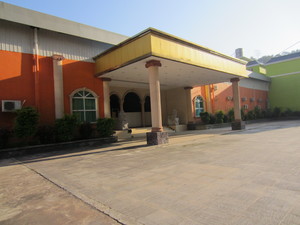
A Casino - empty today.
It was definitely one of the more interesting places on my trip.
Pictures from Boten
Saturday, December 21. 2013
Hallstatt in China
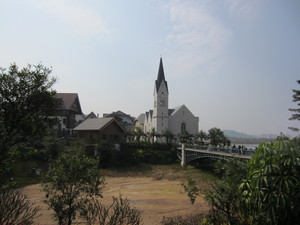
Hallstatt in China's Guangdong province
It was a bit tricky to get there. I found only limited information online. The place is near Luoyang, which is part of an area called Boluo, near the town Huizhou. Getting to Huizhou was mostly hassle-free, there are many trains every day from Guangzhou and it takes about two hours. How to come to Luoyang/Boluo is another story. I had two bus numbers I found in some Internet forums, but I couldn't find them at the train station. So either the information was wrong or the buses with that numbers are departing from another place in Huizhou. I also had some GPS coordinates I found online of the copycat Hallstatt, but it turned out later that they were not very accurate.
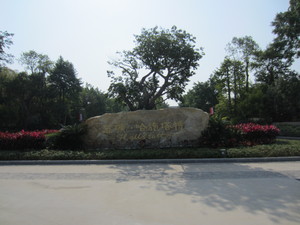
The entrance
What is interesting to know is that this place isn't primarily a tourist destination. It's a housing development, people are supposed to live here. However, I think nobody lives here yet, because except for the town's center, everything is still in construction. There are a number of similar projects in China. Tianducheng in eastern China, which rebuilts parts of Paris, has gotten quite a lot of media attention lately as an example for the Chinese housing bubble. Almost nobody lives there and it's mostly a ghost town. As the chinese Hallstatt isn't yet ready to house anyone, the future will tell if it'll fall to the same fate.
There were a number of things that made this place weird. The most obvious thing: You usually don't see tropical plants in an austrian town. I have no idea why they had a (fake/nonworking) red, british-style phone booth. Maybe for a chinese Britain isn't that far from Austria after all. Although this place isn't primarily meant as a tourist destination, it certainly attracts a lot of them. It was quite crowded. I haven't seen anyone who looked like being from Austria though.
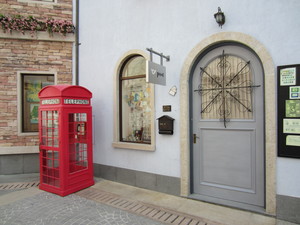
British style fake phone booth
I'd like to finish with a quick comment. When reading western news commenting about this case and others, they're often quick in condemning this kind of "copycat" culture. I think one needs to be careful with that. The importance of the "original" is something that is deeply rooted in cultural norms and traditions. Sticking to the original is something that's probably more important in European cultures than in China. But I don't think either of them is right or wrong, it's just a different approach to culture. After all, it doesn't hurt anybody if someone is rebuilding Austrian villages in China. Also, there is almost certainly no legal issue at stake here. While it may be debatable if a town's layout can be covered by copyright, Hallstatt is a historic city. So if there is any copyright on it, it's already expired.
Pictures from Luoyang
Pictures from Chinese Hallstatt
Some Links:
Blog entry about Hallstatt / China on thechinachronicle.com
Blog entry about Hallstatt / China on liongrass.hk
Friday, December 13. 2013
Fastest overland route from Europe to China
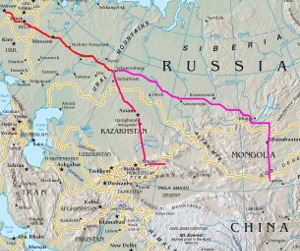 The well-known way of getting from Europe to China overland is the transsiberian railway. However, I noted that the route through Kazakhstan I took is the quickest way to get to China by train and bus. I thought I'd write that up:
The well-known way of getting from Europe to China overland is the transsiberian railway. However, I noted that the route through Kazakhstan I took is the quickest way to get to China by train and bus. I thought I'd write that up:- Take train EC 43 from Berlin Hauptbahnhof (09:37 on Monday, Berlin time) to Warsaw Wschodnia, change to train D 10SZ (15:28). If you - like me - feel that the time to switch trains is a bit risky in case of delaqys, you can take the earlier Beriln-Warsaw-train EC 41 (06:37 until 12:08). There's also a direct Berlin-Moscow-train D 50472 (Berlin 04:28, Moskwa Belorusskaja 10:33), but it's often sold out early.
- Spend some time in Moscow and then take the Metro Line 5 (Circular Line) to Komsol'skaya (Metro of Kazasky railway station)
- Take train 090У from Moscow Kazansky (18:48 on Tuesday, Moscow time) to Petropavl/Petropavlovsk in Kazakhstan (09:46 on Thursday, Astana/Almaty time). Note that this only works every second Tuesday - you may choose other days where this train goes, but then other options may not work.
- Take train 152T from Petropavl (13:48 on Thursday, Astana/Almaty time) to Almaty (22:28 on Friday, Astana/Almaty time).
- Take bus number 100 to Sayran bus station and hope that they'll sell you a ticket late in the evening for the bus next morning. Find a place to sleep (but not very long).
- Take bus from Astana Sayran bus station (07:00 on Friday, Astana/Almaty time) to Yining (approx. 21:00 on Friday, Beijing time). You're in China.
With the transsiberian, you can leave Berlin on Monday (same options as above until Moscow) and take the D4ZJ direct train from Moscow to Beijing. You will enter China in Erlian on the next Monday at 00:47. So this makes almost 7 days vs. about 4 and a half days.
I wouldn't recommend anyone doing that. Better spend some time on the way and see some places in Russia or Kazakhstan. Also it should be noted that one obvious reason for being faster is that you'll enter China at a place much further in the west. And getting to the main part of china (the western part is much less inhabited than the eastern part and all big cities are in the east) can be somewhat troublesome. Still, I thought it might be of interest to document the fastest overland way from Europe to China.
I always assumed the starting point Berlin, obviously because I live there, adapting that to other starting places should be trivial. For example you can usually easily (and for a comparatively cheap price) reach Berlin by Eurolines bus in a day from other major european cities like Paris or London.
Saturday, December 7. 2013
Xi'an, capsule hostel, chinese pyramids and more
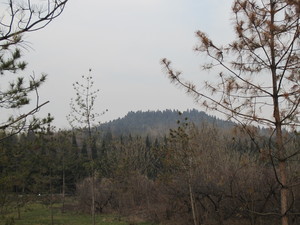
The great pyramid of China (I admin it doesn't look that spectacular and pyramid-like)
Between Dunhuang and Lanzhou, I took what is called the "hard seat" class for a 14 hour ride (not overnight). I can quote Wikivoyage on that:
"Traveling in a seat (hard or soft-class) means you will share the car space with lots of locals. You will most likely encounter smokers, loud noise, and constant activity in the aisle while you try to sleep. *Do not* travel hard class if you are uncomfortable with these settings."
While I certainly was an interesting experience, it is not exactly one I'd like to repeat. It was challenging and I was quite happy when I finally arrived.
With my arrival in Xi'an, finally I noticed that I approach the warmer zones of China. While not really "summer-warm", I apprechiated not having to wear winter clothes all the time. Appart from that, Xi'an was quite different from the other cities I've visited before. It is in many small ways much more like a western city (and, to be not mistaken, in many ways this is a good thing - better hygiene, less dangerous traffic, no smoking in non-smoking zones). And regarding my last blog post, yes, coffee is usually available, although often expensive.
Xi'an is also home of one of Chinas most popular tourist attractions, the so-called terracotta warriors and - not that well known - the Chinese pyramids. I didn't know that there are pyramids in China, so found that worth seeing. Unlike pyramids in other places of the world, the chinese pyramids are not buildings, they are artificial hills. The biggest one, near the terracotta warriors, is the mausoleum of Chinas first emperor Qin Shi Huang.
My initial plan was to visit the pyramid and then decide if I still had time and motivation to see the terracotta warriors. I took the bus to the terracotta warriors and walked the roughly two kilometers to the pyramid. Turned out my planning was not really how one was supposed to do things. Going to the pyramid is only possible with an entrance ticket for the terracotta warrior museum - and you cannot buy it at the entrance of the pyramid area. There's a free shuttle service which I then took to get the ticket and drive back.
The pyramid doesn't look that spectacular and there's hardly a spot where you can actually see it's a pyramid. It once was much bigger, but during the centuries, the earth got compressed and it became smaller. I walked around a lot, the area around is a nice park.
As it is common amongst tourist destinations probably everywhere in the world, there is a huge amount of people who want to sell you things - from terracotta warrior replica in all sizes (including ones in original size and made mostly out of the same materials than the original ones) to the various tour guides. I refused all these offers and preferred to find my own way. One more thing notable: This isn't mainly a tourist spot for foreign tourist. The vast majority were domestic tourists.
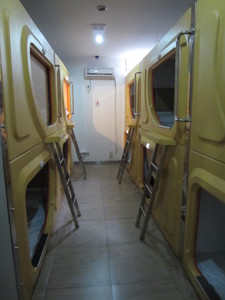
Capsule Hotel in Xi'an
While writing this, I'm in the highspeed train from Xi'an to Guangzhou (taking only 8 hours). I've been to Guangzhou before, and I'm not going there not mainly because I want to see something there. I have a double-entry 2 x 30 days visa and from Guangzhou, I intend to make a quick hop to Hong Kong. Although part of China, in visa issues Hong Kong is like going to another country. So by going to Hong Kong, I have another 30 days to spend in China. Arriving in Guangzhou, I can also finally leave any traces of the northern hemisphere winter behind myself. It has comfortable temperatures all year round.
Pictures from Xian
Pictures from Guangzhou
Posted by Hanno Böck
in English, Life
at
04:06
| Comments (0)
| Trackbacks (0)
Defined tags for this entry: asia, asia2013, capsulehotel, china, pyramid, terracottawarriors, train, xian
Monday, December 2. 2013
No coffee in northwest China
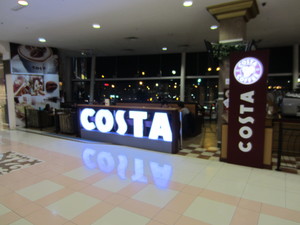
Costa Coffee is expanding to Asia - this one's in Astana
When travelling, I usually have my own coffee making equipment, which consists of a couple of coffee filters, a collapsable filter holder, some coffee powder and some coffee creamer powder (which doesn't make a very delicious coffee and I prefer real milk or soy milk if possible, but it's a reasonable compromise when travelling).
I was running out of coffee powder shortly after I entered China. I really hadn't expected that it would be a problem. After all, the biggest international coffee chains, Starbucks and Costa Coffee, are flooding eastern and southern China with their restaurants and Chinese chains and independent coffee houses are trying to keep up with that. Well, the problem is that I entered China in the far northwest. And the Chinese love for coffee hasn't made it there yet.
I could hardly believe this, but between Yining and Dunhuang, I didn't find any coffee. None at all. Not in the form of coffee powder and not in brewed form. Yeah, supermarkets have a large collection of soluble instant coffee, most of it Nescafe and also some Chinese brands. But I refuse to call that stuff coffee. Most of it contains more sugar than anything else. When you get coffee in restaurants at all, you can bet it's also instant coffee. I checked where the next Starbucks is: In Xi'an, thousands of kilometers away. I checked for the next Costa Coffee: Also in Xi'an. (I'm on my way to Xi'an now - no, not just because of the coffee, it was my plan anyway.)
After all, I bought some non-sugared instant coffee. No, I wasn't happy with it, but it seemed it was the best I could get.
Lesson learned: There's just no coffee in northwest China.
Saturday, November 30. 2013
Through Western China and no train tickets from Urumqi
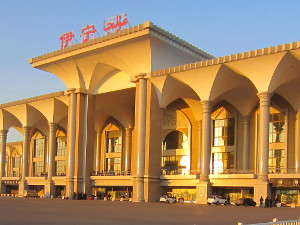
Train station in Yining
I took the train from Yining to Urumqi. My original plan was to move along quite fast and directly take the next train to Xi'an. But that didn't really work. I had to find out that all train tickets for the upcoming days to every location east of Urumqi were sold out. This was kind of a déjà vu. Last time I was in China I had the plan to travel this way in the other direction - and no tickets were available. Reading local news, this situation might improve 2014, when a new highspeed train line opens between Urumqi and Lanzhou. I didn't want to wait that long though.
However, this time I knew that there are alternatives - by taking the bus. I took a bus to the town Dunhuang, which is about 1,000 kilometers east of Urumqi.
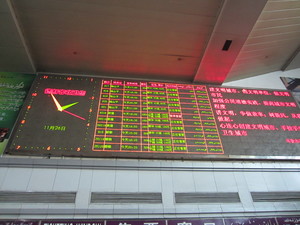
Bus times in Urumqi
The bus trip through the Xinjiang desert passed a lot of wind turbines. While China is often portrayed as the environmental bad guy, one shouldn't fail to recognize that it's also the world leader in building renewable energies. However, the many Xinjiang wind turbine fields also told the other not so green side of the Chinese renewable boom: Many of the turbines were just standing still. The most likely reason: China is building up wind power faster than it's caring for grid integration. I'm used to that look in Germany - wind power there is also often downregulated, because grid integration is not keeping up with the installation of new wind energy. But it was quite obvious that this problem is far bigger here in China's desert.
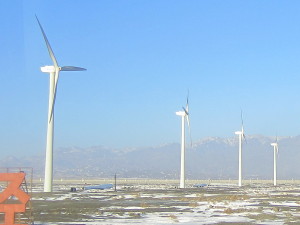
Wind energy in Xinjiang
Tomorrow I'll take the train to Lanzhou.
Pictures from Yining
Pictures from Dunhuang
Pictures from wind power turbines in the Xinjiang province
Pictures from Lanzhou
Tuesday, November 26. 2013
By Bus from Almaty/Kazakhstan to Yining/China
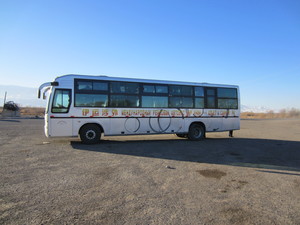
Our bus
I read at some places about a different possibility: A bus service from Almaty to Yining (伊宁 which, to make things complicated, has also a kazakh/uighur name - Kulja / Құлжа / قۇلجا - which, to make things even more complicated, can be written in many different ways using latin characters, cyrillic characters or arabic characters). The information was quite scarce. I basically only had a few forum entries mentioning it, so all the information I had seemed quite unreliable. And even the guy from the hostel where I stayed didn't know more.
I could find out that there's an international bus station in Almaty called Sayran (сайран). It is located somewhat outside the city and can be reached with bus number 100 from the Almaty 2 train station. I went there on Thursday and - although without language communication possible - could tell them what I wanted. They wrote me down a date and time for the next bus: Saturday at seven in the morning. Sadly, I didn't find out how often this bus goes. Saturday was fine for me so I bought my ticket for the bus.
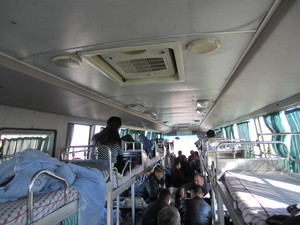
Beds and most people sitting on the floor
We spend about an hour at a restaurant in the middle of the desert and also some time at the border. I was a bit worried about the border crossing, because recently there have been some conflicts in the Xinjiang province, which is the chinese province you enter when coming from Kazakhstan. But at the border everything was fine, except that my border crossing took a bit longer than the others.
Right behind the border a lot of people were trying to offer money exchange. I didn't do that, because at such points you usually don't get the best exchange rates, which later turned out to be a mistake. It seems not exactly easy to change Tenge into Renminbi in Yining and as I'm writing this, I still have some Kazakh money with me after having tried to exchange it in three different banks in Yining.
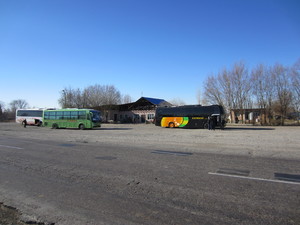
Lunch break in the desert - this really felt like being in the middle of nowhere
Hopefully this information will provide other travellers some help when they try to take this bus. To recap the important information:
- Bus from Almaty to Yining starts at Sayran bus station (reachable via local bus 100 from Almaty 2 train station).
- Runs at 07:00 a.m. on unknown weekdays, but due to my experiences probably on fridays and not on thursdays (If you have any info on that, e. g. a link to the bus company, please add it in the comments).
- Costs 4600 Tenge (thats about 21 € or 30 US$).
- Takes about 12 hours.
- Crosses border to China at Khorgas (霍尔果斯 in mandarin chinese, قورعاس in uighur, Хоргос in russian and Қорғас in kazakh language).
Pictures from bus trip
Saturday, November 23. 2013
Almaty and the little Alps
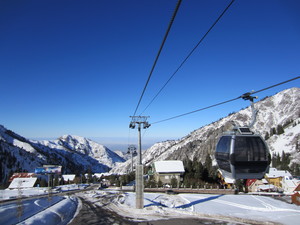 After Astana I went on to Almaty, which is the former capital of Kazakhstan. As I already wrote my previous two stops (Petropavl and Astana) were sharp contrasts, Almaty again was a completely different place. While also relatively expensive, it doesn't have the kind of "artificial" feeling that is present in Astana.
After Astana I went on to Almaty, which is the former capital of Kazakhstan. As I already wrote my previous two stops (Petropavl and Astana) were sharp contrasts, Almaty again was a completely different place. While also relatively expensive, it doesn't have the kind of "artificial" feeling that is present in Astana.I spend two days here. Almaty has some mountains surrounding it. There are two hilltops that one can reach via cable car. One is Koktobe, which has something like a small amusement park on the top. But due to lots of snow, most things there were closed. For the free software fans upon my readers: I saw an arcade machine with Tuxracer there. Never seen Tuxracer in an arcade machien before (however, I have seen an arcade machine with the free software game Stepmania on my last trip).
The other cable car starts near the ice skating stadium Medeo (which can be reached via public bus line 6) and goes to the ski ressort Shymbulak. The ski resort was closed and sadly, this meant that also the second cable car, which could bring one even more up the hills, was also closed. Still I had some stunning views on the mountains. In the gondola, I talked to a local who spoke a bit of English. He said they call it the "little Alps". I found that quite described it well. It really looked like you were in Austria or Switzerland. To make this impression complete, the cable car was even built in Switzerland.
Pictures from Almaty
Friday, November 22. 2013
Astana - the Dubai of Kazakhstan
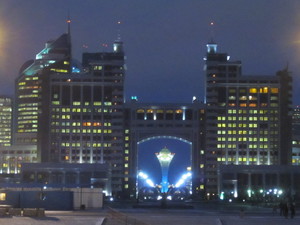
Baiterek from the West ...
I am glad that I've been both in an I assume average Kazakh city like Petropavl and the capital Astana. The contrast was pretty extreme. It wasn't like going to another city in the same country, it felt more like going to another world. Petropavl looked more or less like many post-soviet cities I've been before. Often a bit shabby, with waste laying around, broken or non-existent sidewalks and alike.
Astana is quite the opposite. Nothing here is old, large parts of Astana were build within the last two decades. Dirt or waste in the streets was almost zero and the traffic seems pretty civilized. Until 1997, Almaty was the capital of Kazakhstan, due to some complicated political compromises, it was moved to Astana and there began the growth of this boom town.
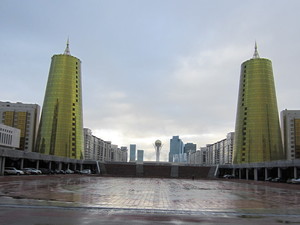
... and from the East
One thing that's notably missing in Astana: It has only a very limited public transport system. There's no metro, no tram and no trolleybusses. Normal busses are the only way to get around. In the evening, they are so crowded that it can be a pain to use them. Also, it's a bit tricky to find out which busses you want to take. Bus stations have sometimes maps with bus lines, but they don't show all bus lines, only the ones starting at exactly that bus stop. I didn't see any complete bus map anywhere offilne or online. I've pictured a bus map (and another one) which features some of the more important lines linking the city center with the train station, maybe this is of some help for other travellers.
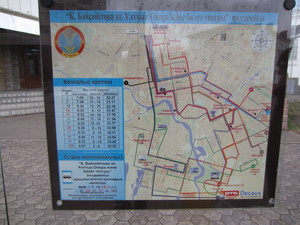
Astana Bus map
I originally planned to stay until saturday and take the train to China from Astana, but I found that the options of exploring the city were quite limited. You pretty quickly get around having seen all of its sights and there doesn't seem much around worth visiting. So I went on to Almaty.
A quick overview of things one can do and i did in Astana:
- Go on Baiterek tower: Not too expensive and nice view on the city with signs of distances to other relevant cities (e. g. Beijing 3656 km, Moscow 2280 km, Helsinki 3020 km).
- Ocenarium in the Duman entertainment center: Not that cheap, but nice and quite relaxing atmosphere. Biggest attraction are two large tunnels under a big aquarium, so you can watch the fishes from below.
- Pyramid (Palace of Peace and Reconciliation): Pyramid formed building containing an opera, conference centers and more. Not really worth visiting, it was mostly boring. I was the only english speaking person at that time, which didn't stop them from giving me a guided tour through the building.
- Khan Shatyry: Mostly a shopping center (so not thatwah interesting, except for the fact that it's a tent-like architecture). The upper floor contains a mix of an amusement park and an arcade hall. I saw a lot of those entertainment complexes, most other shopping centers in Astana have something alike. Also, there's a "Beach Club", which is a very expensive swimming bath.
- Watch unusual architecture: All over the city center.
Pictures from Astana
Posted by Hanno Böck
in English, Life
at
13:36
| Comments (0)
| Trackbacks (0)
Defined tags for this entry: architecture, asia2013, astana, baiterek, kazakhstan, khanshatyry, petropavl, travel
Thursday, November 21. 2013
Visa Registration in Kazakhstan
When I crossed the border to Kazakhstan I was told that I had to register my visa within 5 days. I read about that before, but I thought I had read somewhere that this wasn't necessary for EU citizens, so I was a bit surprised. But it turned out registration wasn't that difficult.
I did the registration on Monday in Astana. Registration needs to be done at the Migration Police office, which is located in the улица Сакена Сейфулина 29. I was there at 11:00 and the place was quite crowded and busy, so I already feared this might take some time. But it only took a couple of minutes, I gave them my passport, my migration card and a business card of my hotel (they wanted to know the adress). Then I was told to come back at 15:00. I was also told that they could only do a registration for a maximum of ten days. This wasn't a problem for me, because I don't intend to stay longer in Kazakhstan and my Visa validity ends there anyway. But for travellers wanting to stay longer in Kazakhstan this might be a cause of trouble.
After all, it wasn't that troublesome, but you should be aware of the registration when travelling to Kazakhstan. I don't know what to do if you're not passing a big city and thus have no way to visit the office of the migration police.
I did the registration on Monday in Astana. Registration needs to be done at the Migration Police office, which is located in the улица Сакена Сейфулина 29. I was there at 11:00 and the place was quite crowded and busy, so I already feared this might take some time. But it only took a couple of minutes, I gave them my passport, my migration card and a business card of my hotel (they wanted to know the adress). Then I was told to come back at 15:00. I was also told that they could only do a registration for a maximum of ten days. This wasn't a problem for me, because I don't intend to stay longer in Kazakhstan and my Visa validity ends there anyway. But for travellers wanting to stay longer in Kazakhstan this might be a cause of trouble.
After all, it wasn't that troublesome, but you should be aware of the registration when travelling to Kazakhstan. I don't know what to do if you're not passing a big city and thus have no way to visit the office of the migration police.
Sunday, November 17. 2013
Petropavl in northern Kazakhstan
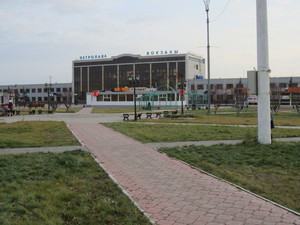 After a two-night train trip I arrived in Kazakhstan in the town Petropavl / Петропавл, also known under the name Petropavlovsk (which should not be confused with Petropavlovsk in Russia, where a town with the same name exists). There was no particular reason why I went there except that there's a relatively fast train from Moscow. Going directly from Moscow to Kazakhstan's capital Astana or the ex-capital Almaty would've meant a trip with at least three nights in a train, which I thought would be too much.
After a two-night train trip I arrived in Kazakhstan in the town Petropavl / Петропавл, also known under the name Petropavlovsk (which should not be confused with Petropavlovsk in Russia, where a town with the same name exists). There was no particular reason why I went there except that there's a relatively fast train from Moscow. Going directly from Moscow to Kazakhstan's capital Astana or the ex-capital Almaty would've meant a trip with at least three nights in a train, which I thought would be too much.There's surprisingly little information you find online about Petropavl in English, although it's not that small (about 200.000 inhabitants). I can't add that much, as I only stayed for one night.
I had a booking for a hotel, which teached me a little lesson: Sometimes preparing to much may cause more hassle than it helps. I didn't find the hotel I've booked at the address where it was supposed to be. You may wonder how I fail to find a hotel, but you need to know that "hotel" here not necessarily means the same as you are used to be (big building with big sign "Hotel XY"). They're often hidden in flats inside normal buildings.
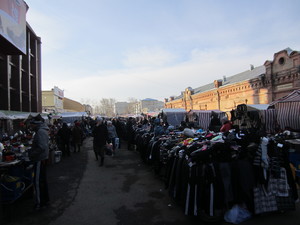 After checking the booking again I found out that it listed two addresses. One for the apartment and one as the contact address - and they were not nearby. No hint where I was supposed to go. While searching for my hotel, I found three other hotels which, by the way, were all much cheaper than everything that was bookable online. So finally I decided to forget my booking and just took one that seemed okay. Luckily, I could cancel my other booking without costs (I would've complained if I hadn't been able to do so) and ended up in a fine apartment, cheaper than planned and with a kitchen.
After checking the booking again I found out that it listed two addresses. One for the apartment and one as the contact address - and they were not nearby. No hint where I was supposed to go. While searching for my hotel, I found three other hotels which, by the way, were all much cheaper than everything that was bookable online. So finally I decided to forget my booking and just took one that seemed okay. Luckily, I could cancel my other booking without costs (I would've complained if I hadn't been able to do so) and ended up in a fine apartment, cheaper than planned and with a kitchen.Notable in Petropavl was a huge outdoor market. Although it's quite cold, it was crowded and seemed to be the normal way of shopping here. Not only food was sold, but anything from clothes to tools or car parts.
After spending a night, I took the train to the capital Astana.
Pictures Train Moscow-Petropavl
Pictures from Petropavl
Friday, November 15. 2013
Moscow and the Museum of Soviet Arcade Machines
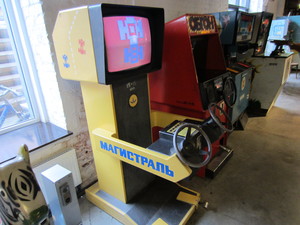 I had about six hours time in Moscow before entering my next train. A bit too much time for getting from one train station to another, eating and sitting around. So I looked for something to do while being in Moscow. I already visited the basic sights like the Red Square last time I was in Moscow, so I was looking for something more unusual.
I had about six hours time in Moscow before entering my next train. A bit too much time for getting from one train station to another, eating and sitting around. So I looked for something to do while being in Moscow. I already visited the basic sights like the Red Square last time I was in Moscow, so I was looking for something more unusual.I checked the Wikivoyage page of Moscow and one of the first things it mentions is the Museum of Soviet Arcade Machines. That sounded like it's worth a visit. I checked the location and it is quite centrally located, only a few minutes walk from the Metro station Baumanskaya. (If you exit the metro, you're already on Baumanskaya street and the Museum is in Baumanskaya street 11.)
As the name says, the museum features arcade machines from the soviet aera. You get a couple of real soviet 15 Kopek coins when entering that you can spend on playing. So I played some rounds of Magistral (Магистраль) - seems something like the soviet answer to Pacman - and others. Honestly, for many of the games I failed to understand how they were supposed to be played. What was interesting that there were a couple of "games" that featured non-virtual content. For example, there was a game where you could control a little toy tank called Tankodrom (танкодром), but I didn't really understand how to play that game either. Obviously there were quite a number of games with cold war references. The Museum also includes some tables where you can have a coffee after playing. If you ever happen to be in Saint-Petersburg, the museum has a branch there, too.
After that I went to Kazansky railway station where my next train was leaving. Moscow has several train stations and some of them are named after the countries where their international trains are heading. So for me that meant I entered Moscow at the Belorussky railway station (because I came through Belarus) and I left at Kazansky railway station (because I was heading to Kazakhstan). (someone in the comments told me this is wrong and Kazaksny station refers to the city Kazan - so I was probably wrong on this naming)
Pictures from the Museum of Soviet Arcade Machines in Moscow
Posted by Hanno Böck
in Computer culture, English, Life, Retro Games
at
16:45
| Comment (1)
| Trackbacks (0)
Defined tags for this entry: arcade, asia2013, computerhistory, magistral, moscow, museum, retro, retrogames, russia, tankodrom
Entering Russia and the migration card
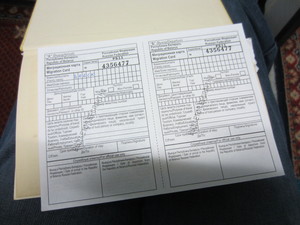
Russian migration card
The migration card is a double-form where you have to fill in some of your basic data. It's then stamped by the border guards and split in half. They keep one half, you get the other and keep it until you leave the country again. From what I've heard, one of the more troublesome things you can encounter is losing your migration card while in Russia.
There are some tricky things to know about the migration card. First: If you enter Russia through Belarus, you'll get only one migration card for both countries. That bothered me a lot on my last trip, because I only entered the data for Belarus, that means a stay of one day. Turned out this wasn't a big issue. When leaving Russia the border guards had a more closer look on the documents and obviously noticed the misinformation, but they didn't seem to care that much.
There seem to be similar issues with other countries. I even once got a migration card at the Ukrainian border, where I didn't want to enter Russia at all. It just happened that I was sitting in a train that was going to Russia after crossing the Ukraine. So if you ever happen to enter Russia through another country, although you don't necessarily get the migration card at the Russian border, you should enter the data for your stay in Russia.
Another thing I learned this time: There is a field for the Visa number. Now I obviously had two Visa - one for Belarus and one for Russia. I filed the number of the Russian one, because after all, I wanted to go to Russia and only cross Belarus on a train. Turned out I was wrong and the Belarus border guards complained. Admittedly, it can be a bit frightening if a border guard tells you something is wrong, especially if you don't understand their language. But after all, he just filled in the correct Visa number himself and everything was okay.
Kazakhstan also has a migration card, but it is not split in half and no similar pitfalls seem to occur there.
Tuesday, November 12. 2013
Travelling again
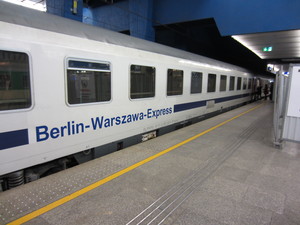 If you've been reading my blog back in 2011, you'll remember that I did a two-month-long trip on the transsiberian railway through Russia, Mongolia and China. Ever since the idea was in my head that I wanted to do something alike again.
If you've been reading my blog back in 2011, you'll remember that I did a two-month-long trip on the transsiberian railway through Russia, Mongolia and China. Ever since the idea was in my head that I wanted to do something alike again.So today I am starting a new journey to Asia, again mostly by train. Slightly modified from last time, as I don't need to see all the places again I've already been. I started today at 6 am in Berlin and I'm currently in Warsaw, Poland (where the 19th world climate conference is just starting, but that's purely a coincidence). I'll only spend a couple of hours in Warsaw and then will continue my trip to Moscow. From there, I'll head on to Kazakhstan and later to China. If everything works out as intended, I'll hopefully spend parts of the winter in warm and sunny areas.
I make no promises, but I'll try to keep my blog updated with pictures and events happening on my trip.
Technical note: All entries related to this trip will be marked with the tag asia2013. All entries related to my previous trip to asia can be found under the tag trip2011. Pictures will be collected here.
(Page 1 of 1, totaling 15 entries)